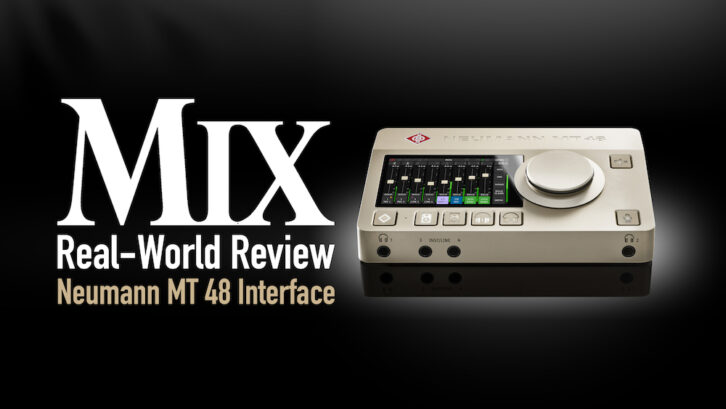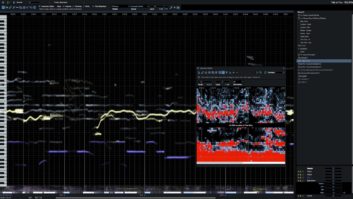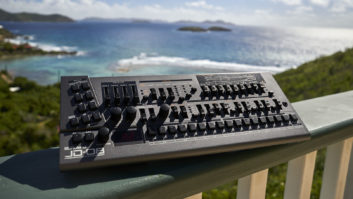
| MIX VERDICT: NEUMANN MT 48 INTERFACE |
| THE TAKEAWAY: “As with the company’s other products, it’s high in both quality and price.” |
| COMPANY: Neumann • www.neumann.com PRICE: $1,850 PROS: • Pristine-sounding preamps and converters. • Onboard touchscreen control. • Excellent monitor-control features, including built-in talkback mic. • App and web-based remote-control. • Built-in dynamics, EQ and reverb. • Flexible configuration options. • Built-in, adjustable Crossfeed for headphone outputs. • Solid metal chassis. CONS: • Web app has a sluggish response. • TRS-to-DIN adapters for MIDI ports not included. |
After Sennheiser purchased Neumann in 2005, the latter began to expand its product lineup beyond microphones. It launched its first studio monitors in 2010 and its first headphones in 2019. This year, the Berlin-based company has broadened its portfolio again by releasing its first audio interface, the MT 48. As with the company’s other products, it’s high in both quality and price.
If you’re familiar with the Merging Technologies Anubis interface, you’ll notice some distinct similarities between it and the MT 48. That’s because Sennheiser purchased Merging in 2022, in part to bring the company’s audio interface technology into the Neumann line, so it’s not surprising that the MT 48 is based heavily on the Anubis while offering USB-C connectivity and a significantly lower price.
The MT 48 includes built-in dynamics, EQ and reverb, excellent onboard touchscreen control, and app-and web-based remote control. It even comes with a padded carrying case with the Neumann logo embossed on top.
AROUND THE HORN
The MT 48 is a compact tabletop interface housed in a solid metal chassis that’s the same color as Neumann microphones. It’s powered by an included (multi-country) USB-C external power supply.
The interface includes four analog inputs (two XLR mic/line and two 1/4-inch Hi-Z/line) and four analog outputs (two XLR main and two 1/4-inch TRS line), as well as ADAT/S/PDIF in and out on Toslink optical ports.
If you include the potential I/O from the ADAT optical port, which is eight channels at 48 kHz (four at 96 kHz, two at 192 kHz), the potential total I/O count is 12-in and 12-out. Counting the two separately addressable TRS headphone outputs adds another four outputs.
Additionally, there’s an RJ45 port that supports AES67, an open standard used in broadcast and audio production. You can connect to Neumann monitors through it, and the bi-directional port can carry high-channel-count/high-sampling-rate, networked audio in a compatible system.
Neumann also equipped the MT 48 with 1/4-inch GPIO/MIDI In and Out ports. In GPIO mode, you can plug in footswitches and other compatible remote controls. In MIDI mode, you can connect MIDI gear using TRS-to-DIN5 adapters (not included).

Most of the I/O is located on the rear panel. with TRS inputs 3 and 4 (Instrument/Line) on the small, front-facing part of the unit, as are the headphone jacks. A mic-stand mount is included on the bottom of the unit, making it easier to integrate the MT 48 into live performances.
I did notice that the enclosure gets hot to the touch when the unit is on for a while. After reading the manual, I discovered that the heat is a feature, not a bug: The case is designed to function as a heat sink. In addition, there’s an ultra-quiet fan inside the frame, which, in its default setting, only turns on when the room temperature gets unusually high.
PRESSING AND TURNING
All of the MT 48’s functions can be controlled via the knobs, buttons and touchscreen on the top panel. The latter is an LCD multitouch display, approximately 3.5 by 2.25 inches. In its default state, the screen is the control interface for a mixer capable of four simultaneous mixes (each on its own page in the software), blending the input signals with the audio returning from your DAW.
Mixer channels feature volume faders, pan sliders and solo buttons. Tapping on the channel name lets you access the built-in DSP functions, such as Preamp controls, EQ, Dynamics and Reverb, along with other utility functions. Through the Settings menu, the MT 48 provides significant customization.

Each mix is routed to an output pair: Speaker A, Speaker B, Headphones 1 or Headphones 2. Each output pair has a dedicated selector button on the top panel. When you press it, the appropriate mix appears on the touchscreen.
The MT 48 also offers a comprehensive set of monitor control functions. Monitor switching is available through the Speaker A and Speaker B buttons. One of the top-panel buttons turns on a built-in Talkback mic, which you can set to latch in the unit’s Settings section. From there, it’s possible to change the talkback mic’s gain and specify which of the four mixes will receive the signal. You can even route it through Input 4 to record it in your DAW.
The Mute button shuts off the currently selected output. If you hold it down for more than two seconds, it shuts off all the outputs.
Sennheiser MD 441-U Lego Set — A Mix Not-That-Real World Review
On the right side of the mixer is the Home screen, a vertical row of buttons for various functions, including switching mixes, DIM, Mono, Solo Clear and Menu (which offers access to the Settings menu and other preferences). One notable option in Settings is Crossfeed, which sends some of the left channel into the right, and vice-versa, which simulates listening on speakers when monitoring on headphones. You can even adjust the amount of the effect. If you mix on headphones regularly, it’s a handy feature.
The front panel also features a large Rotary Controller knob that governs volume and gain adjustments, excluding those controlled by the channel faders. The Rotary Controller is located close to the right side of the touchscreen, and several times I accidentally activated one of the software buttons, such as DIM or Mono, when turning it. (Because I’m left-handed, my ring finger and pinkie hang over the side of the knob when I turn it, bumping the buttons. I’m guessing that a right-hander would be fine.)
That aside, the onboard user interface, including the touchscreen, switches and knobs, is extremely well-designed and intuitive.

GOING REMOTE
Controlling the MT 48 remotely from a Mac, PC or tablet requires downloading the MT 48 Toolkit from the Neumann site. It contains the Remote Controller app and shortcuts to the Web app. The Remote Controller offers the same controls as the Touchscreen.
The Web app provides an expanded view, but its response is sluggish compared to the Remote Controller. The Web app can also run on a tablet, but you must first connect the MT 48’s AES67 port to your Wi-Fi router with an Ethernet cable.
I discovered that the Remote Controller and Web app, in addition to the Touchscreen, can be open and active simultaneously, which allows you to show different screens on each (for example, the faders from two different mixes), which can be handy during a recording session.
CHANNELING
As you would expect from Neumann, the preamps and converters on the MT 48 are of exceptionally high quality. The dynamic range of the mic inputs is an impressive 136 dB. The gain range on the mic inputs is 78 dB. That’s enough gain for virtually any mic, even low-output dynamic or ribbon models.
The preamps have their own section in the mixer, which features software switches for options like a -12 dB or -24 dB Pad, a 40 Hz, 60 Hz or 80 Hz low-cut filter, 48 V phantom power, and polarity reverse.
You can also insert individual Dynamics and EQ processors on each input or output channel. The Dynamics processor offers three different options—Gate, Compressor and Limiter— which can all be turned on and off separately. The Compressor is relatively transparent and provides plenty of parameter options. One is an Auto-Gain function allowing you to add compression to an input signal without changing its level in the cue mix. The four-band EQ provides multiple filter choices for each band, and a graphic display.
You can use the processing (on each channel) only for monitoring, or you can print it. You can also configure the mixer to output a wet and dry version of a track.
A single Reverb processor is available to all channels via a send. You can globally set parameters such as Reverb Size, Decay, Predelay, Low Cut, High Cut and Diffusion. Reverb, EQ and Dynamics settings can all be saved for later recall using the Snap (snapshots) function available on each processor’s screen.
REAL WORLD
I used the MT 48 as my interface for several weeks and was highly impressed. My recordings, both of miked and DI sources, were amazingly clean and crisp. The headphone amps sound excellent and have plenty of power. The overall sound quality is exceptional.
It’s not just the sound, however. The built-in effects and all the user-configurable options make the MT 48 super-versatile.
I also love the Touchscreen. Although I had the Remote Controller app and Web app at my disposal, I ended up using the Touchscreen most of the time because it’s just so convenient—the issue with accidentally pressing the software buttons aside.
Yes, the MT 48 is costly on a per-channel basis, but you’re getting studio-quality sound. It’s a similar proposition to buying a Neumann microphone: You have to pay more for exceptional performance. As long as the channel count is sufficient for your needs, you’ll be glad you invested in the MT 48.







